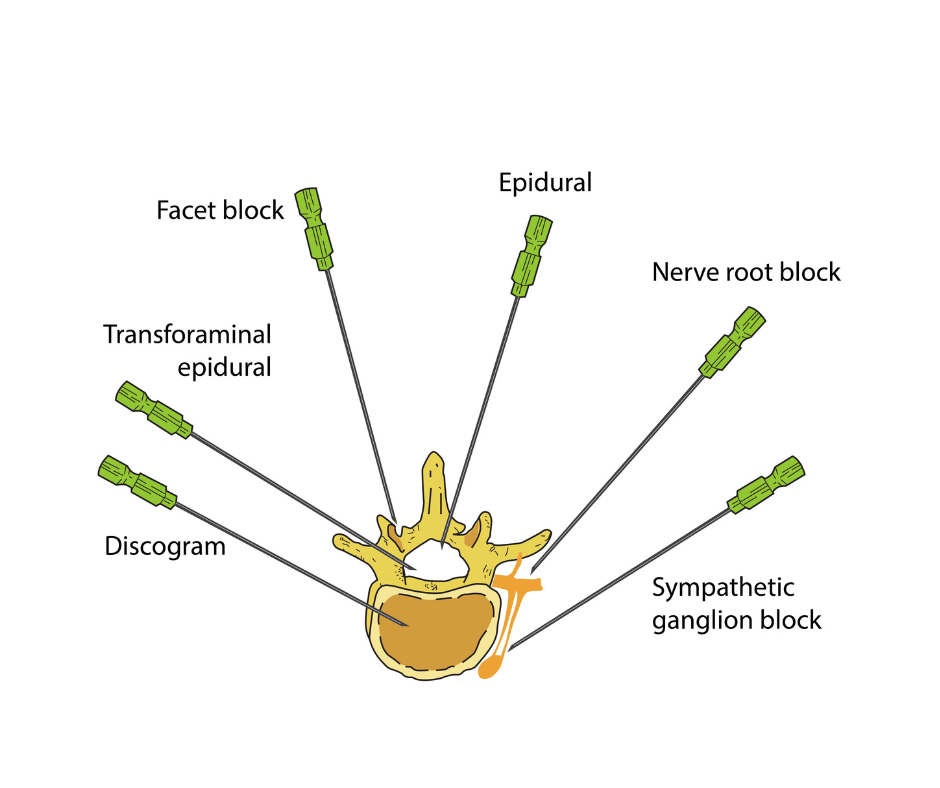Spinal Injections
Spinal injections are injections given near nerves, or sometimes into facet joints to treat inflammation (swelling and irritation), and reduce the pain effectively of patients suffering from spinal problems. Unlike oral medicines, injections deliver medicine directly to the site of pain and have a focused impact with fewer side effects. The purpose of spinal injections is to reduce the amount of inflammation (swelling, pain) around the nerves resulting in pain relief.
The spinal injection contains a small dose of anti-inflammatory medication and at times therapeutic steroids to relieve pain. This helps to reduce pain and inflammation and is used to treat a variety of diseases and painful conditions like sciatica, slip disc, lumbar or cervical disc herniation, Lumbar or Cervical Spinal Stenosis, Sacroiliac joint inflammation, facet arthropathy etc.
Spinal Injections can be broadly categorised into 3 types –
- Disc Injections
- Epidural Injections
- Facet Injections
Disc Injections:
This is done to reduce the pain generated from disc degeneration. In this, a specific type of radiofrequency current is used to numb the nerves which cause pain from the degenerated intervertebral disc. The procedure is called biacuplasty.
Epidural Injections:
The most common spinal injection is the epidural injection. An epidural injection can help control local inflammation by removing chemicals from the local area that may contribute to and exacerbate pain.
This injection is to be given in the spinal epidural space. This is the space alongside your spinal cord (not inside of it). Nerves come out from the Spinal cord through this space. This technique requires a C Arm machine for the precise placement of medication in the Transforaminal Epidural Space. The medication is injected into an area of fatty tissue surrounding the spinal nerves. Spinal Injection can be both a treatment and a way to diagnose a specific nerve root problem when there is a question.
Common Epidural injections are –
- Transforaminal epidural Injection
- Cervical epidural injection
- Caudal epidural injection
- Translaminar epidural injection
- Epidural Adhesiolysis
Facet Injections:
Facet joints are synovial joints which are present between two adjacent vertebrae. These injections are placed into joints of the cervical spine in neck or lumbar spine in low back.
This injection is given when pain is coming from a specific facet joint. Some examples of facet joint injections are –
- Facet joint diagnostic blocks
- Facet joint medial branch radiofrequency neurotomy
In radiofrequency neurotomy, a small amount of electrical current is used to block the nerves that carry the pain sensation from the facet joint. This gives pain relief for a long time. In this procedure, a needle is placed near the medial branch nerve to complete the ablation/neurotomy procedure.
Apart from the above three categories, Sacroiliac joint injections are used to deliver medications into the Sacroiliac joint that connects the hip bones with the spinal column. It reduces inflammation of SI joint.
Most of the patients at Spinalogy Clinic can be treated with integrative multidisciplinary treatments and surgery is not required. The following are some of the details of spinal injections administered at Spinalogy:
- Spinal injection is usually a day care procedure administered under local anaesthesia.
- The patient can go home within one hour after the procedure.
- Spinal injection procedures are relatively safe and there are rare to none serious side effects or complications from the procedure.
- Rarely does a patient require more than one injection. Repeat injections are based on pre-treatment goals and the therapeutic response following the injection.
Not all patients with spinal pain or slip disc require spinal injections. Your specialist decides whether you require spinal injections depending upon clinical evaluation, response to earlier treatments, investigations such as X-rays, MRIs, etc.




